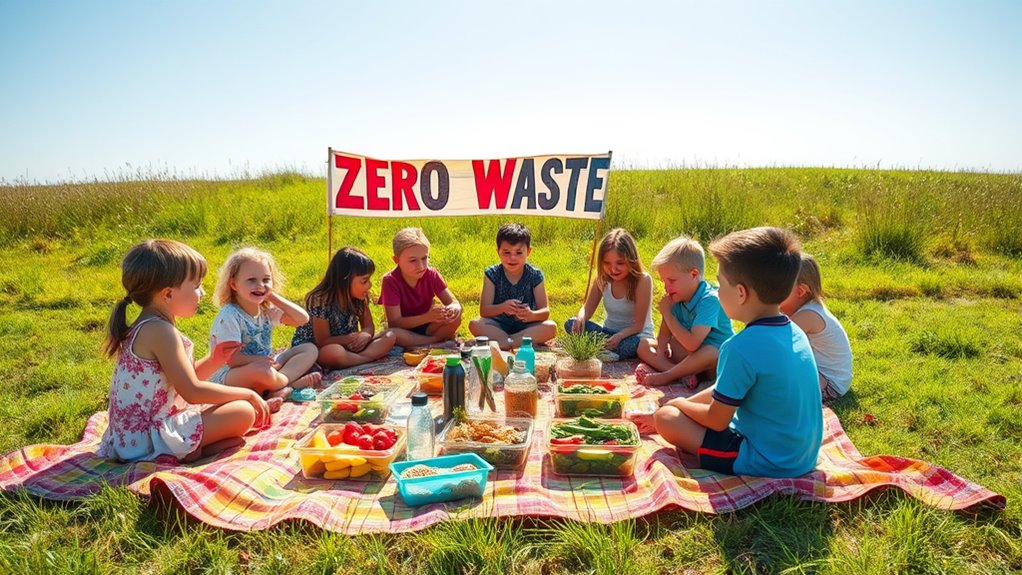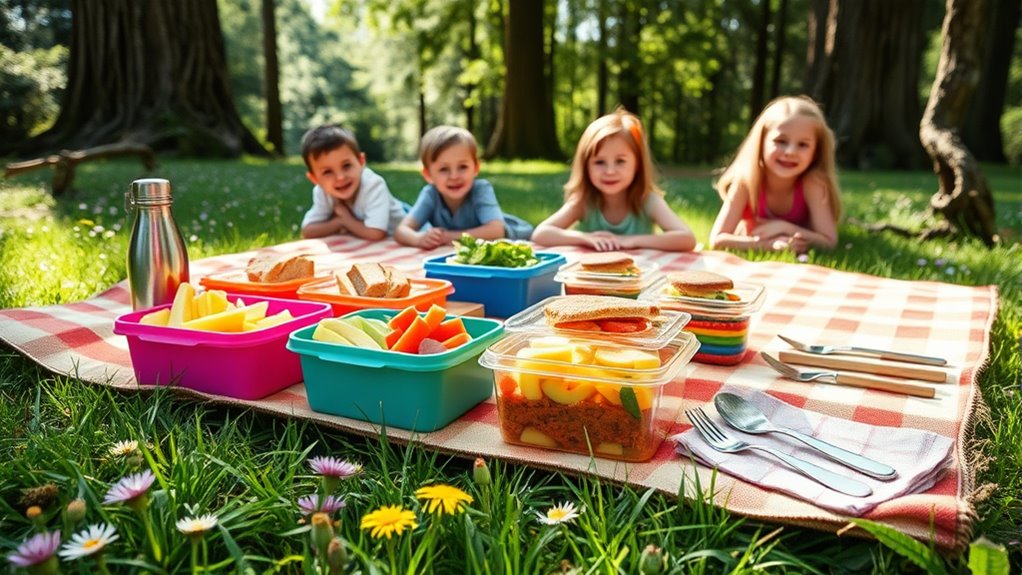To pack a zero-waste picnic, choose reusable utensils, plates, and cups to cut down on plastic waste. Wrap snacks in beeswax wraps and fill reusable bottles to avoid single-use packaging. Bring a small compost bin for organic scraps and organize waste sorting stations. Encourage kids’ participation to teach them about sustainability and leave the site clean. If you keep exploring, you’ll find simple ways to make your outdoor feast more eco-friendly and fun.
Key Takeaways
- Pack reusable utensils, plates, and cups to minimize single-use waste and involve kids in eco-friendly packing.
- Use beeswax wraps and reusable containers for snacks, reducing plastic packaging and promoting sustainability.
- Bring a small compost bin or bag for organic waste like fruit peels, teaching kids about composting and waste reduction.
- Designate waste sorting areas and encourage children to properly dispose of recyclables and compostables.
- Choose eco-friendly napkins and encourage cleanup to leave the site pristine, fostering environmental responsibility in kids.

Planning a zero-waste picnic is a simple yet impactful way to enjoy the outdoors while reducing your environmental footprint. When packing your picnic, focus on using reusable utensils instead of disposable ones. Bring stainless steel or bamboo cutlery that kids can enjoy using again and again. Not only do these utensils cut down on plastic waste, but they also add a fun, eco-friendly touch to your outdoor meal. Encourage children to help pack and clean up their utensils, making the experience educational and empowering. Additionally, opt for reusable plates, bowls, and cups—these will serve your family well for multiple outings and reduce the need for single-use disposables.
Enjoy outdoor meals with reusable utensils and dishes to reduce waste and make your picnic eco-friendly.
As you prepare your food, think about composting tips to manage waste responsibly. Use compostable napkins or cloth alternatives, and bring along a small compost bin or bag for organic scraps. This way, you can dispose of fruit peels, vegetable trimmings, and other biodegradable waste properly, turning leftovers into nutrient-rich compost rather than trash. If your outdoor space doesn’t have a composting facility, check local parks or community centers for options, or consider setting up a simple composting system at home. Teaching kids about composting during your picnic can foster a deeper understanding of sustainability and help cultivate eco-conscious habits early on. Incorporating waste management practices into your outing not only minimizes environmental impact but also teaches children the importance of responsible disposal.
When packing snacks and meals, choose items that generate minimal waste. Wrap sandwiches in beeswax wraps instead of plastic wrap, and pack dry snacks in reusable containers. These small changes not only prevent unnecessary packaging but also keep your food fresh and easy to access. Remember to bring a reusable water bottle for each person, avoiding single-use plastic bottles that often end up in landfills or oceans. Filling bottles from a larger container or using a filtered water system keeps everyone hydrated without adding waste.
During your picnic, be mindful of waste management. Designate a specific area for trash and recyclables, and make sure everyone knows what goes where. Encourage kids to participate in sorting waste into appropriate bins, turning clean-up into a fun learning activity. After the meal, carry out all your waste, leaving the site as pristine as you found it. This respect for the environment ensures that natural spaces remain beautiful for others to enjoy and helps instill a sense of responsibility in young eco-enthusiasts.
Frequently Asked Questions
How Do I Include Biodegradable Utensils in My Picnic?
To include biodegradable utensils in your picnic, start by choosing eco-friendly cutlery made from materials like bamboo, cornstarch, or plant-based plastics. Pack these biodegradable utensils in your picnic basket along with other eco-friendly supplies. They’re sturdy and compostable, making them perfect for reducing waste. By using eco-friendly cutlery, you help minimize your environmental impact and set a great example for kids to adopt sustainable habits during outdoor adventures.
What Are Some Eco-Friendly Packaging Options for Snacks?
Imagine you’re a pioneer of eco-friendly picnics! For snacks, choose reusable snack bags made from fabric or silicone, which cut down waste and are super practical. Alternatively, opt for compostable packaging like plant-based wrappers or biodegradable containers that break down naturally. These options help protect our planet and keep your picnic green and clean. By making these eco-friendly swaps, you turn every outdoor feast into a sustainable adventure!
How Can I Teach Kids About Waste Reduction During Picnics?
You can teach kids about waste reduction during picnics by making recycling education fun and interactive. Show them how to sort recyclables and explain why it matters. Incorporate composting tips by involving them in composting food scraps, highlighting their role in reducing waste. Use stories or games to reinforce eco-friendly habits, encouraging kids to be mindful of waste and make sustainable choices during outdoor activities.
Are There Sustainable Outdoor Picnic Tableware Options?
Did you know that switching to sustainable outdoor picnic tableware can considerably cut waste? You can choose reusable options like stainless steel or bamboo utensils, plates, and cups that last for years. Alternatively, opt for compostable materials such as plant-based plates and cutlery, which break down naturally after use. These eco-friendly choices help reduce landfill waste and teach kids the importance of caring for the environment during outdoor fun.
How Do I Store Leftovers Without Generating Waste?
To store leftovers without creating waste, use reusable containers instead of single-use plastic bags. Make sure they’re clean and airtight to keep food fresh. When you finish, consider composting food scraps and biodegradable packaging to reduce landfill waste. Reusable containers make cleanup easier, help cut down on waste, and keep your leftovers fresh longer, aligning with eco-friendly practices and encouraging responsible waste management.
Conclusion
Next time you pack a zero-waste picnic, imagine the kids spreading out their reusable cloths, fruits gleaming in the sun, and everyone enjoying eco-friendly bites. It’s like turning a simple outdoor meal into a small act of kindness for the planet. As you see their happy faces and the fresh, empty containers afterward, you realize that every thoughtful choice you make can help create a greener world—one picnic at a time.










